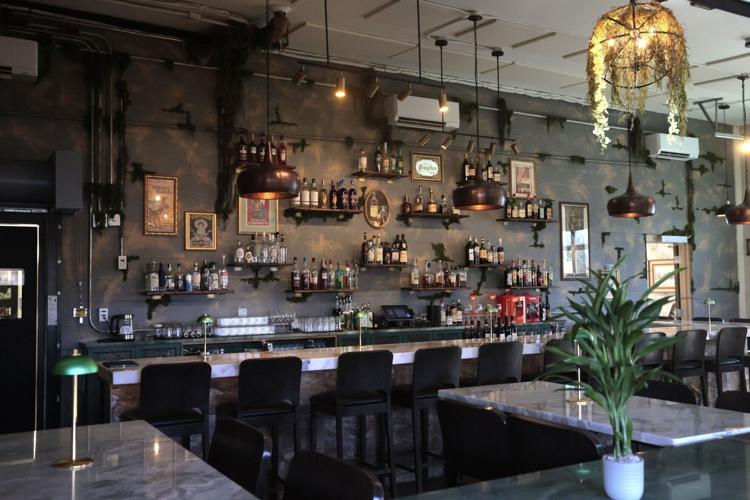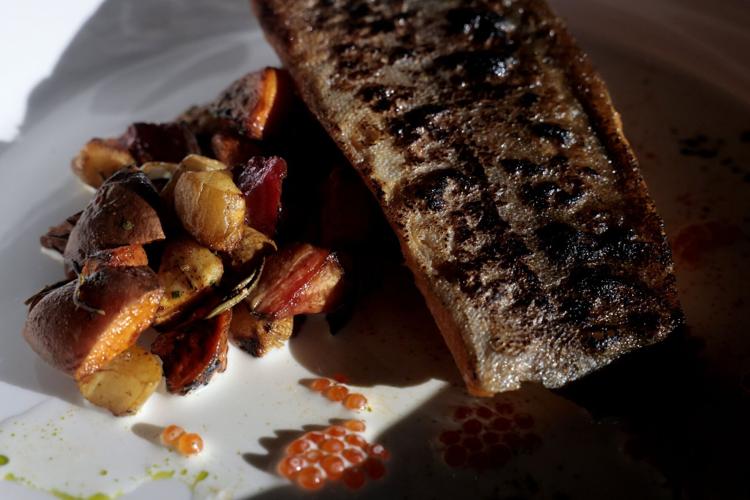Don’t bother predicting the new year’s hottest dining trends. The first true revelation of 2025 is a piece of Ricola-glazed pork at the second attempt to launch a new concept underneath the best restaurant in St. Peters.
Yes, that Ricola, the famed Swiss candy and natural cough suppressant. At Bormio, located on the lower level of Noto Italian Restaurant, chef Wayne Sieve plates Ricola-glazed coppa (a shoulder cut) atop beer-braised cabbage that retains its snap and vibrant purple hue. Ricola’s blend of 10 wild herbs, punched up with Braulio amaro, is the ideal accent for the pork’s sweet succulence, as bracing and resonant as notes through an Alpenhorn.

Bormio owners, husband and wife team, Wayne and Kendele Sieve pose for a portrait in front of a mural of Venus in the foyer of their restaurant.
Sieve has more than earned the benefit of the doubt for his work at Noto. Still, I didn’t expect to love this dish. Then again, Sieve and his wife, Kendele, didn’t originally plan to open an Alpine-inspired restaurant. Yet thankfully here we are at Bormio.
People are also reading…
The Sieves could have taken the obvious route of converting the space below Noto into overflow seating for that restaurant. Since debuting in January 2020 — and in spite of the pandemic’s arrival only a couple of months later — Noto has established itself as the metro area’s premier Neapolitan pizzeria and one of the best Italian restaurants of any kind. You might walk in and nab a seat at the bar, but the dining room’s size mandates reservations.
Instead, inspired by their 2023 trip to Venice, Italy, the couple transformed the lower level into Bacaro, which opened in March of last year. The name referenced a style of bar in Venice that features apéritifs and the small bites called cicchetti, a format the Sieves loved and embraced for their new venture.

The interior of Bormio.
Bacaro’s customers pushed back on the menu, though. They wanted more substantial dishes, especially if they ended up at the new restaurant because Noto was full. The Sieves reduced the number of cicchetti and introduced a few main courses.
Then the Sieves faced a more existential challenge: a trademark claim on the name Bacaro. They decided to scrap not only the name, but the entire Venetian concept. In its place, they looked to Italy’s far north. The eponymous Bormio is a town near the border with Switzerland and also relatively close to Austria. The Sieves didn’t know this area, though Wayne and Noto chef Justin McMillen had dabbled in its cuisine for a wine dinner highlighting the region.
The Ricola-glazed coppa is the most striking example, but you don’t need to reach for your cough drops to understand how Bormio differs from the typical ÃÛÑ¿´«Ã½ Italian restaurant. The menu’s brief selection of main courses leads with the German influence of sauerbraten, tender beef short ribs with an undeniable vinegar smack. The dish travels into Italy on a bed of creamy polenta, and crème fraiche lightens its flavor (if not its heft), but as with the pork, the vital invigorating note is botanical: sprigs of pungent dill.

Sauerbraten at Bormio in St. Peters.
Bormio’s food is as gorgeous as it is delicious. The coppa and its cabbage arrive on a floral-patterned plate, and its garnishes include tiny flowers, snipped herbs and a little mound of mustard seeds. A piece of Arctic char is served crisp, browned skin up in a velouté dotted with neon-green Strega liqueur and stippled with orange trout roe beside roasted root vegetables glistening with smoked paprika-toasted caraway butter. The char’s flesh, luscious like salmon, soaks up the silky velouté and the butter’s warm spices alike.
Unintentionally, maybe, the Sieves have flipped several years’ worth of upscale dining becoming ever more casual. Bormio’s design follows from Bacaro’s original plan for apéritifs and cicchetti. A long, gleaming bar is the central focus of the space, with additional hightop tables along the perimeter. Yet the sleek, cocktail-sipping vibes — reservations taken, but walk-ins more than welcome — cloak some of the most grownup cooking I’ve encountered in recent years.

Spinach dumplings at Bormio in St. Peters.
Of course, you can also visit Bormio for drinks and a few bites. Let’s call them smaller plates rather than small. You slather the thick, tangy, quark cheese-based Alpine dip on crusty, chewy pretzel rolls, and three plump spinach dumplings gooey with melted gruyère and Parmigiano Reggiano and glistening with nutty brown butter could easily pass as a light main course. The lightest bite is the most luxurious: baked oysters nubbly with gremolata and breadcrumbs and jolted by the heat of ‘nduja sausage.
If I must speak about trends at Bormio, I’ll salute the best nonalcoholic cocktail I’ve tried, the Alpine Elixir, a tart, herbaceous concoction for those who miss an arrestingly botanical gin-and-tonic. It’s refreshing, not too sweet (the mocktail’s usual flaw) and nearly as soothing as a Ricola.

Oysters nduja at Bormio in St. Peters.

Pesce (Arctic char) at Bormio.
Post-Dispatch photographers capture hundreds of thousands of images each year. Take a look at some from January 2025. Video edited by Jenna Jones.

















